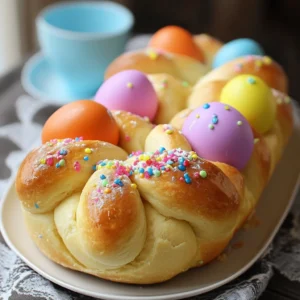Step 1: Prepare the Dry Ingredients.
In a large mixing bowl, combine 2 cups of the all-purpose flour, granulated sugar, rapid rise instant yeast, lemon zest, and orange zest. Mix well with a spoon or whisk to ensure the yeast is evenly distributed. This step is crucial for activating the yeast and incorporating the flavors. Set aside.
Step 2: Warm the Milk and Butter.
In a microwave-safe bowl or measuring cup, combine the whole milk and unsalted butter. Heat the mixture in the microwave in short intervals (about 30 seconds at a time), stirring in between each interval. The goal is to warm the mixture until the butter is melted and the milk is warm to the touch (around 110°F/43°C), but not scalding. Overheating the milk can kill the yeast, so be careful! Alternatively, you can melt the butter and warm the milk in a saucepan over low heat.
Step 3: Combine Wet and Dry Ingredients.
Add the eggs and vanilla extract to the bowl of dry ingredients. Pour in the warmed milk and butter mixture. Using the dough hook attachment of a stand mixer, mix the ingredients on low speed for about 1 minute, or until a shaggy dough forms. The mixture will be quite wet and resemble a thick cake batter at this stage. Don't worry, it will come together as you add more flour.
Step 4: Knead the Dough.
Gradually add the remaining 2 cups of flour to the mixer, about 1/2 cup at a time, while continuing to mix on low speed with the dough hook. Once all the flour is incorporated, increase the speed to medium-low and knead the dough for about 8 minutes. The dough should become smooth, elastic, and slightly tacky, but it should not stick to the bottom of the bowl. If the dough is still too sticky, add flour, one tablespoon at a time, until it reaches the desired consistency.
Step 5: First Rest.
Place the dough on a lightly floured surface or a silpat mat and knead by hand a few times to bring it together into a smooth ball. This helps to develop the gluten and create a more even texture. Try to use as little flour as possible to prevent the dough from becoming dry. Place the dough into a clean bowl, lightly greased with oil or butter, and cover with plastic wrap. Let it rest for 15 minutes.
Step 6: Shape the Bread.
Remove the dough from the bowl and gently punch it down to release any trapped air. Divide the dough into 8 equal pieces. Roll each piece into a rope approximately 11 inches long. Pinch two ropes together at one end and braid the two pieces together. Form the braid into a ring and pinch the ends together securely to create a sealed circle.
Step 7: Second Rise.
Place the braided rings on a baking sheet lined with parchment paper. This prevents the bread from sticking and makes for easy cleanup. Cover the rings loosely with plastic wrap and let them rise in a warm place for about 30 minutes to 1 hour, or until they have doubled in size. The rising time will depend on the temperature of your kitchen. A warm environment will speed up the process.
Step 8: Preheat Oven and Prepare Egg Wash.
While the dough is rising, preheat your oven to 375°F (190°C). Prepare the egg wash by whisking together the egg and milk in a small bowl until well combined. This egg wash will give the bread a beautiful golden-brown color and a slightly shiny finish.
Step 9: Egg Wash, Decoration, and Baking.
Once the dough has finished rising, gently brush the surface of each ring with the egg wash using a pastry brush. Be careful not to deflate the dough. Nestle an uncooked, dyed Easter egg into the center of each ring. Sprinkle the rings with colorful sprinkles for a festive touch. Bake for 20 minutes, rotating the baking sheet halfway through to ensure even baking.
Step 10: Cool and Serve.
Let the bread cool on a cooling rack before serving. Easter Bread is best served warm.
